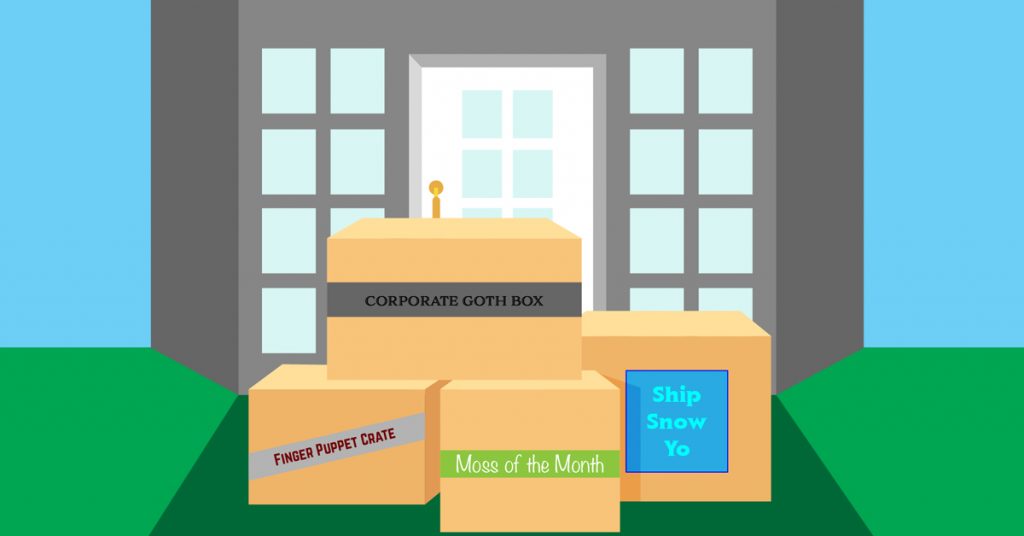CALL: 985-778-0798
What’s in the Box?

Online shopping started in 1994 and spread like wildfire in 2017. As a result, nearly 79% of Americans shop exclusively online. People have ditched waiting in long lines, driving through traffic, and searching for the best bargain by simply scrolling through the World Wide Web. It doesn’t get much simpler than being able to type in anything that you are looking for and setting filters to narrow it down to your preferred product. Business owners discovered they needed to be innovative and develop a new way to sell their goods online. Thus came the birth of an entirely unique time in online shopping: The Box Pop.
Subscription boxes are everywhere. Chances are if you are on the internet, there’s at least one subscription box beckoning your wallet. Birchbox put the subscription box retail trend in motion with its launch in 2010, with a specialty in beauty, grooming and lifestyle products. Birchbox subscribers pay $10-$20 to receive goodies like skin rejuvenators, fragrances, and makeup. This company has 800,000 active global subscribers which equal a total of $96 million in annual sales.
Just like with any successful business model, the imitators quickly followed suit. There are subscription boxes for everything from razors, tactical gear, video games, clothing, and of course: food. In 2012, Blue Apron was founded and is now known as the gold standard for food delivery services. Each Blue Apron box contains enough food for you and your family (2-4 people) and offers a very reasonable price range ($59.94 – $69.92).
Subscription boxes have risen to fame because of three different reasons: convenience, personalization, and excitement. Subscription boxes are a perfect example of experiential marketing, a strategy that directly engages consumers and encourages them to participate in the evolution of a brand or a brand experience. Therefore, creating a consumer-producer relationship with the brand.
Convenience
There’s nothing more convenient than coming home from a long day’s work to see a box on your doorstep full of goodies; meal kits offer a hassle-free way to prepare dinner after work. Some consumers don’t like to get off of work and then face the stress of determining a recipe, shopping for ingredients, and preparing a meal. With meal subscription boxes, all of that is taken care of for you. There are even specialized subscription meal boxes made for those with particularly demanding schedules such as college students.
Personalization
The difference between the average consumer now compared to ten years ago is the value placed on personalization. After all, we live in a time where there’s a space for each of us on the internet that we can personalize and make our own through social media. Upon subscribing to a box, subscribers are asked a series of questions. Some have a list of all of their products with check boxes for the customer to click, while others have text boxes where customers explain their product preferences in detail. Consumers have the chance to put a little of themselves in their ordering and feel special in the process.
Excitement
You’ve already skipped the stress of real-life shopping, and you have defined yourself by making your product preferences known. Now it’s time for the fun part: the excitement of the box on your doorstep. Because the business asks what makes you tick, you know that the box is going to contain products you will love. But, it’s the feeling of it being a gift and a surprise that really has jump-started this marketing trend. This type of excitement isn’t just trending with subscription boxes either. Unboxing videos routinely take a few of the top 10 spots on most-viewed YouTube watch lists, among the music videos from international superstars and the latest viral prank.
Even though the marketing model for subscription boxes seems to have everything that we as consumers want, some recent news has made many of these business owners wary. The subscription box business is not immune to the same dangers of other, more traditional businesses. Many of these companies have been reporting a dramatic slump in sales and must think of ways to increase sales. The subscription box market is severely saturated, with more than 2,000 different types of boxes to offer and steadily growing. Also, big companies such as Starbucks, Sephora, Macy’s, and Adidas are joining in the craze which is making the smaller companies lose steam rapidly.
What do you think the next step will be for these business owners to stay on top?

